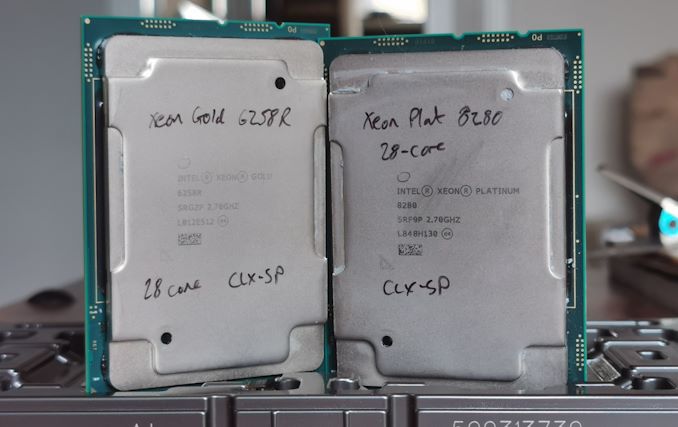In February 2020, Intel launched eighteen new Xeon Scalable second generation processors. These mid-cycle additions to Intel’s product portfolio were designed to bolder up Intel’s server offerings on a very popular and very successful platform, adding in extra cores, extra frequency, or more cache than the previous offerings at roughly the same price. The goal of these ‘performance-oriented’ processors was to address customer requests in offering a more palatable performance-per-dollar offering. One of the new CPUs caught our eye: the Xeon Gold 6258R.
Skylake, Cascade Lake, Refresh
Colloquially known as ‘Cascade Lake Refresh’, these processors are the same silicon as the second generation Cascade Lake Xeon Scalable processors that were originally launched in April 2019. In most cases, the Refresh processors focus on both performance and performance-per-dollar metrics, especially given that Intel’s competition in this space were in a very competitive position and focusing on those values. Despite Intel’s data center revenue growing rapidly through 2019 and into 2020, there was a need to effectively replace or add new products into the areas where Intel believed it could keep a strong grasp on the customer base.
In our original announcement for the refresh parts, Intel touted an average performance gain of 36%, and a performance-per-dollar of 42%, although that was pictured as a 1st Gen to 2nd Gen Xeon Scalable jump. For a lot of the eighteen new processors on offer, they either added extra cores, more cache, or more frequency for the same cost as the parts they effectively replace. This usually comes with an increase in power consumption (there’s no escaping the physics), given there was no actual change to the underlying silicon, it simply was a function of binning and product margin.
One of the new parts was the Xeon Gold 6258R, with the R indicating ‘Refresh’. This processor was actually the highest core count refresh part, offering 28 cores at 2.7 GHz base and 4.0 GHz turbo within 205W.
For anyone who follows Intel’s server processor portfolio, those specifications look *very* familiar. Looking through the list, there is one very popular processor that has the exact same specifications: the Xeon Platinum 8280. Here’s the full breakdown:
| Intel 2nd Generation Xeon Scalable 28-Core Comparison |
||
| Platinum 8280 |
AnandTech | Gold 6258R |
| 28 Cores / 56 Threads | Cores / Threads | 28 Cores / 56 Threads |
| 2700 MHz | Base Frequency | 2700 MHz |
| 4000 MHz | Turbo Frequency | 4000 MHz |
| 38.5 MB | L3 Cache | 38.5 MB |
| 3 x 10.4 GT/s | UPI Links | 3 x 10.4 GT/s |
| 8 | Max Socket Suport | 2 |
| 6 x DDR4-2933 | DDR4 Support | 6 x DDR4-2933 |
| 1 TB | DDR4 Capacity | 1 TB |
| LGA3647 | Socket | LGA3647 |
| 205 W | TDP | 205 W |
| $10009 | List Price | $3950 |
The Platinum 8280 and the Gold 6258R are identical, almost to a fault. The same cores, the same frequency, the same power, and both support Optane DCPMM. The implementation difference is very subtle: where the 8280 supports 8-way socket deployments, the 6258R only supports 2-way. Intel has separated up the 8200 series and the 6200 series in this sole difference of socket support, which is actually more a firmware difference than anything else.
Oh, and the 6258R has a list price over $6000 cheaper.
Now, the reason why this is important comes down to where the 8280 sits in Intel’s Xeon portfolio. It is, for all intents and purposes, the processor that gets the most attention. It sits at the top of its public processor offerings*, it offers the most cores, and the list price is $10009**. If a non-technical executive is requesting ‘the best’ hardware for deployment, they naturally scroll to the most expensive part and add-to-basket. That processor would be the Xeon Platinum 8280.
However, most servers are single socket and dual socket, which essentially nullifies the ‘extra’ 4-socket and 8-socket capability that the Xeon 8280 offers. In this case, Does the 6258R, with the same specifications on core count, frequency, and power, perform the same as the 8280 but at a fraction of the price?
This is the question I set out to answer with access to both CPUs. Saving $6000 per single socket server, or $12000 in a dual socket configuration, would allow purchasers to focus that investment in other areas, such as memory or storage, or bring down the cost of purchasing quite considerably.
Footnotes
*Intel also offers a Xeon Platinum 8284 which also has the 28 cores that the 8280 does but is at a higher base frequency (same turbo) and 240W TDP. The list price is $15460, a +50% jump. This processor doesn’t seem to always be available everywhere, plus it was also launched months after the 8280.
**List prices from Intel are usually set as the price if someone buys 1000 units, so one would expect the individual cost would be slightly higher. However, major OEM partners and big hyperscalers rarely pay the list price, and the separate pricing is negotiated by contract. Rumors are that the big companies that might need a 100k units or more rarely pay more than 20-50%% of the list price. Exact figures are hard to come by.
The Link LonkAugust 07, 2020 at 08:00PM
https://ift.tt/31A94Se
How to Save $6000 on a 28-core Flagship Intel Xeon: Platinum 8280 vs Gold 6258R - AnandTech
https://ift.tt/2YXg8Ic
Intel




No comments:
Post a Comment